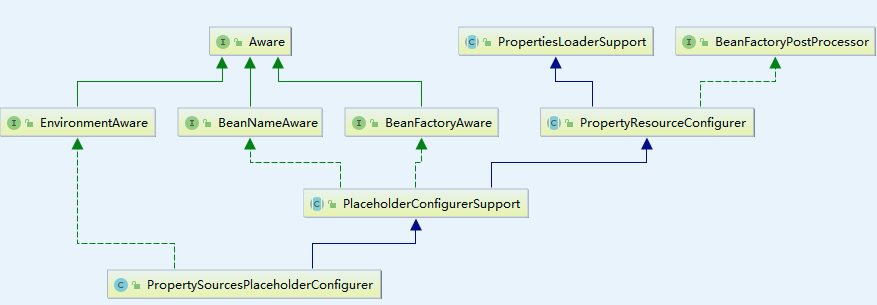【深入浅出Spring原理及实战】「源码原理实战」从底层角度去分析研究PropertySourcesPlaceholderConfigurer的原理及实战注入机制
Spring提供配置解析功能
主要有一下xml文件占位符解析和Java的属性@Value的占位符解析配置这两种场景进行分析和实现解析,如下面两种案例。
xml文件的占位符解析配置
<bean id="dataSource" class="com.alibaba.druid.pool.DruidDataSource" init-method="init" destroy-method="close">
<property name="url" value="${jdbc.url}"/>
<property name="username" value="${jdbc.username}"/>
<property name="password" value="${jdbc.password}"/>
</bean>
Java的属性@Value的占位符解析配置
@Value 注解值进行属性占位符解析和替换
@Value("${config}")
private String config;
PropertyPlaceholderConfigurer和PropertySourcesPlaceholderConfigurer
通过配置xml来实现对Classpath下的配置文件的占位符的属性进行注入,或者实现Java的属性@Value的占位符解析配置。
- 在Spring3.1版本之前是通过PropertyPlaceholderConfigurer实现的。
- 在Spring3.1之后则是通过PropertySourcesPlaceholderConfigurer实现的。
注意:在Spring Context 3.1或者更高版本中,缺省使用PropertySourcesPlaceholderConfigurer工具替换了PlaceholderConfigurerSupport,而<=3.0较老的Spring Context中,为了保持和之前的版本兼容,缺省还是使用PropertyPlaceholderConfigurer。
PropertyPlaceholderConfigurer和PropertySourcesPlaceholderConfigurer的实现分析
- PropertyPlaceholderConfigurer本质是基于PlaceholderConfigurerSupport实现读取配置的。
- PropertySourcesPlaceholderConfigurer是PlaceholderConfigurerSupport的特殊化实现。
下图介绍对应的配置解析的继承关系图谱。

PropertyPlaceholderConfigurer和PropertySourcesPlaceholderConfigurer的执行目标
PropertyPlaceholderConfigurer和PropertyPlaceholderConfigurer在使用上并无本质的区别,两者的根本目标是将配置文件生成KV对,真正的注入工作并不由它们本身执行。
PropertySourcesPlaceholderConfigurer它用于解析bean定义中的属性值,以及注解@Value的值,使用的属性来源是当前的Spring Environment对象,以及设置给自己的PropertySources对象。
Spring Boot 自动配置类 PropertyPlaceholderAutoConfiguration
@Configuration
@AutoConfigureOrder(Ordered.HIGHEST_PRECEDENCE)
public class PropertyPlaceholderAutoConfiguration {
@Bean
@ConditionalOnMissingBean(search = SearchStrategy.CURRENT)
public static PropertySourcesPlaceholderConfigurer propertySourcesPlaceholderConfigurer() {
return new PropertySourcesPlaceholderConfigurer();
}
}
PropertyPlaceholderAutoConfiguration定义一个PropertySourcesPlaceholderConfigurer bean,该bean作为一个BeanFactoryPostProcessor,会在容器启动时容器后置处理阶段执行自己的任务。BeanFactoryPostProcessor的优先级又优于其余的Bean。因此可以实现在bean初始化之前的注入。
postProcessBeanFactory方法的执行
如果外部指定了this.propertySources, 则直接使用它,否则从当前Spring的Environment 对象和自身的 #mergeProperties 方法调用返回的 Properties 对象构建属性源对象 this.propertySources
@Override
public void postProcessBeanFactory(ConfigurableListableBeanFactory beanFactory) throws BeansException {
if (this.propertySources == null) {
this.propertySources = new MutablePropertySources();
if (this.environment != null) {
this.propertySources.addLast(
new PropertySource<Environment>(ENVIRONMENT_PROPERTIES_PROPERTY_SOURCE_NAME,
this.environment) {
@Override
@Nullable
public String getProperty(String key) {
return this.source.getProperty(key);
}
}
);
}
try {
PropertySource<?> localPropertySource =
new PropertiesPropertySource(LOCAL_PROPERTIES_PROPERTY_SOURCE_NAME, mergeProperties());
if (this.localOverride) {
this.propertySources.addFirst(localPropertySource);
}
else {
this.propertySources.addLast(localPropertySource);
}
}
catch (IOException ex) {
throw new BeanInitializationException("Could not load properties", ex);
}
}
processProperties(beanFactory, new PropertySourcesPropertyResolver(this.propertySources));
this.appliedPropertySources = this.propertySources;
}
构造一个基于特定属性源 this.propertySources 对属性值进行解析的属性值解析器PropertySourcesPropertyResolver, 对容器中所有的 bean 定义中的属性值,构造函数参数值。
/**
* Visit each bean definition in the given bean factory and attempt to replace ${...} property
* placeholders with values from the given properties.
*/
protected void processProperties(ConfigurableListableBeanFactory beanFactoryToProcess,
final ConfigurablePropertyResolver propertyResolver) throws BeansException {
// 设置属性值解析器所使用的占位符格式参数,缺省为:
// 占位符前缀 ${
propertyResolver.setPlaceholderPrefix(this.placeholderPrefix);
// 占位符后缀 }
propertyResolver.setPlaceholderSuffix(this.placeholderSuffix);
// 缺省值分隔符 :
propertyResolver.setValueSeparator(this.valueSeparator);
// 结合属性 this. ignoreUnresolvablePlaceholders对propertyResolver 作进一步封装,
// 封装出来一个 StringValueResolver valueResolver,这是最终要应用的属性值解析器
StringValueResolver valueResolver = strVal -> {
String resolved = (this.ignoreUnresolvablePlaceholders ?
propertyResolver.resolvePlaceholders(strVal) :
propertyResolver.resolveRequiredPlaceholders(strVal));
if (this.trimValues) {
resolved = resolved.trim();
}
return (resolved.equals(this.nullValue) ? null : resolved);
};
// 调用基类PlaceholderConfigurerSupport实现的对容器中所有 bean定义进行遍历处理属性值中占位符解析的逻辑
doProcessProperties(beanFactoryToProcess, valueResolver);
}
doProcessProperties的方法目的是为了添加解析器StringValueResolver
protected void doProcessProperties(ConfigurableListableBeanFactory beanFactoryToProcess,
StringValueResolver valueResolver) {
// ignore
....
// New in Spring 2.5: resolve placeholders in alias target names and aliases as well.
beanFactoryToProcess.resolveAliases(valueResolver);
// New in Spring 3.0: resolve placeholders in embedded values such as annotation attributes.
beanFactoryToProcess.addEmbeddedValueResolver(valueResolver);
}
这里的ddEmbeddedValueResolver(StringValueResolver) 是为一个 LinkedList添加值。在取用的时候是优先从链表头开始取用的。 一旦发现无法找到值,直接就抛异常了。这个就对外体现出 PropertySourcesPlaceholderConfigurer 的唯一性。
然而Spring内部还是有多个PropertySourcesPlaceholderConfigurer, 只不过除了排列在队首的 PropertySourcesPlaceholderConfigurer之外全都被忽略掉了。
PropertySourcesPlaceholderConfigurer属性注入的原理
AbstractApplicationContext#obtainFreshBeanFactory
Spring框架进行植入元素注入时机
针对于元素的注入依赖于
AutowiredAnnotationBeanPostProcessor#postProcessPropertyValues1。
AbstractApplicationContext#finishBeanFactoryInitialization方法
在Spring初始化流程中,执行AbstractApplicationContext#finishBeanFactoryInitialization方法。 该方法里面发生的主要流程为Spring业务Bean初始化。 实际流程跟Spring Bean的初始化没有任务区别。
InstantiationAwareBeanPostProcessor
- 通过对接口 InstantiationAwareBeanPostProcessor 实现类的方法进行执行。 仅此而已。
AutowiredAnnotationBeanPostProcessor
- InjectionMetadataInjectionMetadataInjectedElementInjectedElement这个类是 InstantiationAwareBeanPostProcessor的一个实现类。
@Value和@Autowired注解实际执行
用于@Value和@Autowired注解实际执行方法postProcessPropertyValues调度实际调度InjectedElement子类被注入值的获取来自于DefaultListableBeanFactory将对应@Value(“${configValue}”)里面的值替换的来源值,是PropertySourcesPlaceholderConfigurer生成的StringValueResolver。
Spring原生的Bean是单例的它直接被储存在了AbstractBeanFactory执行Field.set(Object, Object)或者Method.invoke(Object, Object[])。
所以,可以看出 PropertySourcesPlaceholderConfigurer 或者 PropertyPlaceholderConfigurer仅仅是做了一个配置文件的解析工作,真正的注入并不由它们完成,而是托付给了Spring 的Bean初始化流程。这两个类实现了BeanFactoryPostProcessor 接口,这个接口的优先级高于后续的Spring Bean。
通过解析了的PropertySourcesPlaceholderConfigurer查询得到元素值。 没有则抛出异常,如下源码:
DefaultListableBeanFactory#doResolveDependency
@Value 注解值进行属性占位符解析和替换
// 获取注解的 value() 值。被写死为 Class<? extends Annotation> valueAnnotationType = Value.class;
// 见类 QualifierAnnotationAutowireCandidateResolver
Object value = getAutowireCandidateResolver().getSuggestedValue(descriptor);
if (value != null) {
if (value instanceof String) {
// 通过PropertySourcesPlaceholderConfigurer写入的键值对元素获取元素的值.
// 方法内注册了多个StringValueResolver,循环查找值。提供者为PropertySourcesPlaceholderConfigurer,因此配置多个解析器的时候是以最后的配置为准的。
String strVal = resolveEmbeddedValue((String) value);
BeanDefinition bd = (beanName != null && containsBean(beanName) ? getMergedBeanDefinition(beanName) : null);
value = evaluateBeanDefinitionString(strVal, bd);
}
TypeConverter converter = (typeConverter != null ? typeConverter : getTypeConverter());
return (descriptor.getField() != null ?
converter.convertIfNecessary(value, type, descriptor.getField()) :
converter.convertIfNecessary(value, type, descriptor.getMethodParameter()));
}
读取配置的方式介绍
xml文件读取配置信息案例
通过PropertyPlaceholderConfigurer进行配置Bean方式
单个配置文件。
<bean id="propertyConfigurer"class="org.springframework.beans.factory.config.PropertyPlaceholderConfigurer">
<property name="location">
<value>conf/sqlmap/jdbc.properties</value>
</property>
<property name="fileEncoding">
<value>UTF-8</value>
</property>
</bean>
多个配置文件
注意这两种value值的写法
<bean id="propertyConfigurer"class="org.springframework.beans.factory.config.PropertyPlaceholderConfigurer">
<property name="locations">
<list>
<value>/WEB-INF/mail.properties</value>
<value>classpath: conf/sqlmap/jdbc.properties</value>
</list>
</property>
</bean>
Spring标签方式
<context:property-placeholder location="classpath*:/WEB-INF/mail.properties" />
这总方式的原理就是构造一个PropertySourcesPlaceholderConfigurer, (3.1之前是PropertyPlaceholderConfigurer)
- ContextNamespaceHandler#init
- PropertyPlaceholderBeanDefinitionParser#doParse
注入配置触发点
Spring初始化Context的时候读取XML配置, 这个流程优先于Spring普通Bean初始化。配合扫包(<context:component-scan />)得到的Bean进而实现对XML里面配置的Bean的载入。
- PropertySourcesPlaceholderConfigurer本质上是一个BeanFactoryPostProcessor。解析XML的流程在BeanFactoryPostProcessor之前, 优先将配置文件的路径以及名字通过Setter传入PropertySourcesPlaceholderConfigurer。
总结Spring Value注入流程
构建PropertySourcesPlaceholderConfigurerBean或者PropertyPlaceholderConfigurerBean的组件
配置Spring @Value("val2Inject") 方式获取配置文件的属性,需要依赖于在Spring XML里面配置<context:property-placeholder /> 或者PropertySourcesPlaceholderConfigurerBean来添加配置文件的名称。
读取到context:property-placeholder标签或者PropertySourcesPlaceholderConfigurer
解析并实例化一个PropertySourcesPlaceholderConfigurer。同时向其中注入配置文件路径、名称PropertySourcesPlaceholderConfigurer自身生成多个StringValueResolver备用,Bean准备完毕。Spring在初始化非BeanFactoryPostProcessor的Bean的时候,AutowiredAnnotationBeanPostProcessor负责找到Bean内有@Value注解的Field或者Method
- 通过PropertySourcesPlaceholderConfigurer寻找合适的StringValueResolver并解析得到val值。注入给@Value的Field或Method。
AutowiredAnnotationBeanPostProcessor负责@Autowired和@Value两个注解的解析。
@PropertySource注解配置读取单个或多个配置文件
单个配置文件:
@PropertySource(value = "classpath:config/application-config.properties")
多个配置文件:
@PropertySource(value = {"classpath:config/application-config1.properties","classpath:config/application-config2.properties"})
@PropertySource注解使用有两种方式
@PropertySource + Environment,通过@PropertySource注解将properties配置文件中的值存储到Spring的Environment中,Environment接口提供方法去读取配置文件中的值,参数是properties文件中定义的key值。
@PropertySource(PropertySourcesPlaceholderConfigurer) +@Value
@PropertySource + Environment
@Configuration
@ComponentScan(basePackages = "com.libo.config")
@PropertySource(value = "classpath:config/application-config.properties")
public class TestPropertieEnvironment {
@Autowired
Environment environment;
public String properties(){
String key = this.environment.getProperty("config.key");
System.out.println(key);
return null;
}
}
配置文件config.properties:
config.key=1
config.value=2
测试类操作
public class Test {
public static void main(String[] args) {
ApplicationContext context = new AnnotationConfigApplicationContext(TestPropertieEnvironment.class);
ServiceConfiguration hc2 = (TestPropertieEnvironment) context.getBean("testPropertieEnvironment");
hc2.properties();
}
}
@PropertySource(PropertySourcesPlaceholderConfigurer)+@Value
PropertySourcesPlaceholderConfigurer是PlaceholderConfigurerSupport的特殊化实现。它用于解析bean定义中的属性值,以及注解@Value的值,使用的属性来源是当前的Spring Environment对象,以及设置给自己的PropertySources对象。
大于3.1更高版本中,缺省使用该工具替换了PlaceholderConfigurerSupport
<=3.0较老的Spring中,为了保持和之前的版本兼容,缺省还是使用PropertyPlaceholderConfigurer。
创建PropertySourcesPlaceholderConfigurer
创建PropertiesConfig
@Component
@PropertySource(value = "classpath:config/application-config.properties")
public class PropertiesConfig {
@Value("${config.value}")
private String value;
@Value("${config.key}")
private String key;
}
测试类忽略!
自定义PropertyPlaceholderConfigurer
@Configuration
@ComponentScan(basePackages = "com.libo.config")
public class PropertiesConfiguration2 {
@Bean
public static PropertyPlaceholderConfigurer configurer() {
PropertyPlaceholderConfigurer ppc = new PropertyPlaceholderConfigurer();
Resource resources = new ClassPathResource( "config/appplication-config.properties" );
ppc.setLocation(resources);
return ppc;
}
@Bean
public Configs2 configs2(@Value("${ds.user}") String user, @Value("${key1}") String key1) {
Configs2 configs = new Configs2();
configs.setApiKeyId(user);
configs.setSecretApiKey(key1);
System.out.println("in ServiceConfiguration" + configs);
return configs;
}
}
@Service
public class TestConfigs2 {
@Autowired
Configs2 configs2;
@Autowired
Configs configs;
public void testConfigs2() {
System.out.println("configs:"+configs.getApiKeyId());
System.out.println("configs2:"+configs2.getApiKeyId());
}
}
测试类
import org.springframework.context.ApplicationContext;
import org.springframework.context.annotation.AnnotationConfigApplicationContext;
public class Test {
public static void main(String[] args) {
ApplicationContext context = new AnnotationConfigApplicationContext(ServiceConfiguration2.class);
TestConfigs2 hc2 = (TestConfigs2) context.getBean("testConfigs2");
hc2.testConfigs2();
}
}
此外需要注意的是:PropertySource是可以支持ignoreResourceNotFound支持无法获取配置文件的i情况。
Spring4版本的PropertySources的注解
在Spring 4版本中,Spring提供了一个新的注解——@PropertySources,从名字就可以猜测到它是为多配置文件而准备的。
@PropertySources({
//@PropertySource("classpath:db.properties"),
@PropertySource(value="classpath:db.properties", ignoreResourceNotFound=true),
@PropertySource("classpath:spring/config.properties")
public class AppConfig {
@Value("${key1}")
private String key1;
@Value("${key2}")
private String key2;
@Override
public String toString() {
return "AppConfig [key1=" + key1 + ", key2=" + key2 + "]";
}
}
【深入浅出Spring原理及实战】「源码原理实战」从底层角度去分析研究PropertySourcesPlaceholderConfigurer的原理及实战注入机制的更多相关文章
- 【Java实战】源码解析Java SPI(Service Provider Interface )机制原理
一.背景知识 在阅读开源框架源码时,发现许多框架都支持SPI(Service Provider Interface ),前面有篇文章JDBC对Driver的加载时应用了SPI,参考[Hibernate ...
- 阿里P7终于讲完了JDK+Spring+mybatis+Dubbo+SpringMvc+Netty源码
前言 这里普及一下,每个公司都有职别定级系统,阿里也是,技术岗以 P 定级,一般校招 P5, 社招 P6 起.其实阅读源码也是有很多诀窍的,这里分享几点心得: 首先要会用.你要知道这个库是干什么的,掌 ...
- Apache Beam WordCount编程实战及源码解读
概述:Apache Beam WordCount编程实战及源码解读,并通过intellij IDEA和terminal两种方式调试运行WordCount程序,Apache Beam对大数据的批处理和流 ...
- Java生鲜电商平台-电商中海量搜索ElasticSearch架构设计实战与源码解析
Java生鲜电商平台-电商中海量搜索ElasticSearch架构设计实战与源码解析 生鲜电商搜索引擎的特点 众所周知,标准的搜索引擎主要分成三个大的部分,第一步是爬虫系统,第二步是数据分析,第三步才 ...
- 七、Spring之深入理解AOP源码
Spring之深入理解AOP源码 在上一篇博文中,我们对AOP有了初步的了解,那么接下来我们就对AOP的实现原理进行深入的分析. 在之前写的那个AOP示例代码当中有这样一个注解:@Enable ...
- SpringCloudGateway微服务网关实战与源码分析 - 中
实战 路由过滤器工厂 路由过滤器允许以某种方式修改传入的HTTP请求或传出的HTTP响应.路由过滤器的作用域是特定的路由.SpringCloud Gateway包括许多内置的GatewayFilter ...
- SpringCloudAlibaba分布式事务解决方案Seata实战与源码分析-上
概述 定义 Spring Cloud Alibaba Seata 官网地址 https://seata.io/zh-cn/ 最新版本1.5.2 Spring Cloud Alibaba Seata 文 ...
- 各个版本spring的jar包以及源码下载地址
各个版本spring的jar包以及源码下载地址,目前最高版本到spring4.1.2,留存备用: http://maven.springframework.org/release/org/spring ...
- Spring Boot 2.0系列文章(五):Spring Boot 2.0 项目源码结构预览
关注我 转载请务必注明原创地址为:http://www.54tianzhisheng.cn/2018/04/15/springboot2_code/ 项目结构 结构分析: Spring-boot-pr ...
- Spring Environment(二)源码分析
Spring Environment(二)源码分析 Spring 系列目录(https://www.cnblogs.com/binarylei/p/10198698.html) Spring Envi ...
随机推荐
- 线程池底层原理详解与源码分析(补充部分---ScheduledThreadPoolExecutor类分析)
[1]前言 本篇幅是对 线程池底层原理详解与源码分析 的补充,默认你已经看完了上一篇对ThreadPoolExecutor类有了足够的了解. [2]ScheduledThreadPoolExecut ...
- P1099 [NOIP2007 提高组] 树网的核 (树的直径)
题目的意思就是在直径上找一段距离不超过s的路径,使该路径的偏心距最小. 求出直径之后,显然我们可以用双指针扫描一段合法路径.设u1,u2...ut是直径上的点,d[ui]表示从ui出发能到达的最远距离 ...
- acwing349 黑暗城堡 (最短路径生成树)
求出最短树,用乘法原理统计答案就行了(模拟prim过程). 不知道说什么了,直接上代码: 1 #include<cstring> 2 #include<iostream> 3 ...
- POJ3398 Perfect Service (树形DP)
对于每个u要设置三维. dp[u][0]表示u是服务器,以u为根的最小服务器数,其子节点既可以是,也可以不是,dp[u][0]+=min(d[v][0],d[v][1]); dp[u][1]表示u不是 ...
- C++/python求哈希值(SHA256)
发现一个很奇怪的现象: python语言求哈希值所用时间竟然比C++少: C++ code 1 #include "stdafx.h" 2 #include <windows ...
- OCI runtime exec failed: exec failed: unable to start container process: exec: "mongo": executable file not found in $PATH: unknown
前言: 今天按照以往在Docker安装MongoDB的方式安装,但是到最后使用mongo命令执行mongodb命令的时候一直执行不成功,最后还是按照官网的Issues解决了. 创建并运行一个Mongo ...
- 20220729 - DP训练 #2
20220729 - DP训练 #2 时间记录 \(8:00-8:10\) 浏览题面 \(8:10-8:50\) T1 看题想到了建树,从每一个点遍历,若能遍历每一个点,则可以获胜 快速写完之后,发现 ...
- 设计一个网上书店,该系统中所有的计算机类图书(ComputerBook)每本都有10%的折扣,所有的语言类图书(LanguageBook)每本都有2元的折扣,小说类图书(NovelBook)每100元
现使用策略模式来设计该系统,绘制类图并编程实现 UML类图 书籍 package com.zheng; public class Book { private double price;// 价格 p ...
- 一天五道Java面试题----第六天(1)
这里是参考B站上的大佬做的面试题笔记.大家也可以去看视频讲解!!! 文章目录 1.mybatis和hibernate的对比 2 .#{}和${}的区别 3 .mybatis插件运行原理及开发流程 4 ...
- Python基础之函数:5、内置函数、迭代器对象、异常的捕获和处理
目录 一.重要内置函数 1.zip() 2.filter() 3.sorted() 二.常见内置函数 1. abs() 2.all.any() 3.bin.oct.hex.int() 4.bytes( ...
